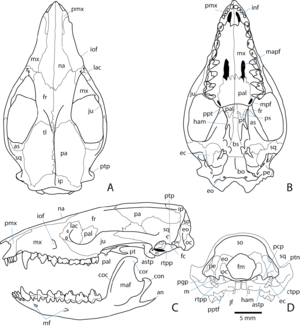Guiana shrew pouch rat
| Guiana shrew pouch rat | ||||||||||||
|---|---|---|---|---|---|---|---|---|---|---|---|---|

Guiana shrew pouch rat skull |
||||||||||||
| Systematics | ||||||||||||
|
||||||||||||
| Scientific name | ||||||||||||
| Monodelphis brevicaudata | ||||||||||||
| ( Erxleben , 1777) |
The Guiana shrew pouch rat ( Monodelphis brevicaudata ), also known as the short-tailed shrew pouch rat , lives in Venezuela south of the Orinoco , in northern Guyana and in northern Brazil north of the Rio Negro and west of its tributary Rio Branco .
description
Males reach a head body length of 14.3 to 17 cm, have a 6.4 to 9.7 cm long tail and reach a weight of 70 to 127 g. Females stay smaller and reach a head body length of 12.8 to 16.1 cm, have a 7.1 to 8.7 cm long tail and reach a weight of 50 to 81 g. The tail has a length of about 50% of the length of the head. It is largely hairless on the underside and only the quarter close to the body is hairy on the top. On the back the animals are colored brownish or brownish gray, some individuals are also colored reddish brown, like the sides of the body. The sides of the head are reddish and a narrow light gray, yellowish or orange central stripe can be seen on the head and snout. There are no dark circles. The peritoneum is cream-colored and gray and contrasts clearly with the reddish sides of the body. The chin and throat are reddish. The fur is about 8 mm long on the back and 4 mm on the belly. The feet are light or dark brown or gray. The ears are small, largely hairless, and light or dark brown or gray. Females do not have a pouch. The number of teats is nine, one in the middle and four on each side. The shape and size of the skull are unequal in males and females. The guiana shrew pouch rat karyotype is unknown. The tail is hairy only at the base and is black above and light below. The ears are hairless and brown.
Habitat and way of life
The Guiana shrew pouch rat lives primarily in lowland rainforests at heights of 95 to 400 meters, but there are occasional finds in higher regions from 620 to 1050 meters. So far nothing is known about the activity patterns, nutrition, reproduction and other behavior of the animals.
Systematics
The German scholar Johann Christian Polycarp Erxleben , who described it in 1777 under the name Didelphis americana , is considered to be the author of the first description of the Guiana shrew pouch rat . The Touan Shrew Opossum ( M. touan ), which in French Guiana and in the northeastern Brazil in the state of Amapá lives, was originally considered a subspecies of the Guiana Shrew Opossum, has been a published in 2012 Revision of Monodelphis-brevicaudata - species complex but the status an independent species. To which species the shrew-pouch rats belong in Suriname has not yet been clarified.
status
The three-lined shrew pouch rat is considered safe by the IUCN . It has a large distribution area, is also found in some protected areas and generally does not seem to tolerate extensive changes in its habitat by humans.
supporting documents
- ↑ a b c d e Diego Astúa: Family Didelphidae (Opossums). in Don E. Wilson , Russell A. Mittermeier : Handbook of the Mammals of the World - Volume 5. Monotremes and Marsupials. Lynx Editions, 2015, ISBN 978-84-96553-99-6 . Page 149.
- ^ Johann Christian Polycarp Erxleben: Systema regni animalis per classes, ordines, genera, species, varietates: cvm synonymia et historia animalivm: Classis I. Mammalia .
- ↑ Silvia Eliza Pavan, Rogerio Vieira Rossi, Horacio Schneider: Species diversity in the Monodelphis brevicaudata complex (Didelphimorphia: Didelphidae) inferred from molecular and morphological data, with the description of a new species. Zoological Journal of the Linnean Society, Volume 165, Issue 1, May 2012, Pages 190-223, doi: 10.1111 / j.1096-3642.2011.00791.x
- ↑ Monodelphis brevicaudata in the endangered Red List species the IUCN 2018 Posted by: Catzeflis, F. Costa, P., Lew D. & Soriano, P., 2015. Retrieved on July 3 of 2019.